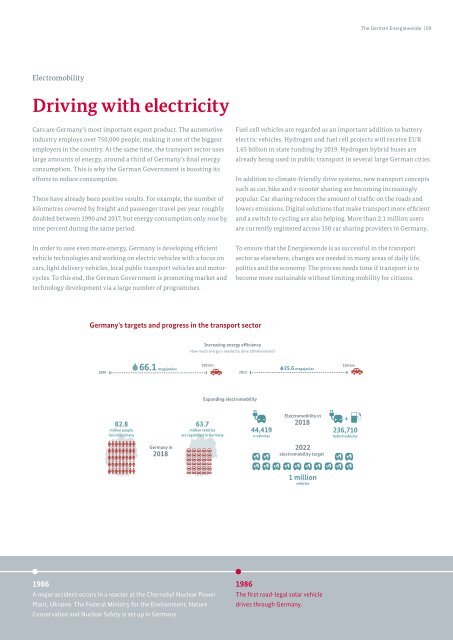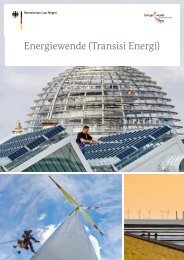The German Energiewende
Create successful ePaper yourself
Turn your PDF publications into a flip-book with our unique Google optimized e-Paper software.
<strong>The</strong> <strong>German</strong> <strong>Energiewende</strong> | 09<br />
Electromobility<br />
Driving with electricity<br />
Cars are <strong>German</strong>y’s most important export product. <strong>The</strong> automotive<br />
industry employs over 750,000 people, making it one of the biggest<br />
employers in the country. At the same time, the transport sector uses<br />
large amounts of energy, around a third of <strong>German</strong>y’s final energy<br />
consumption. This is why the <strong>German</strong> Government is boosting its<br />
efforts to reduce consumption.<br />
<strong>The</strong>re have already been positive results. For example, the number of<br />
kilometres covered by freight and passenger travel per year roughly<br />
doubled between 1990 and 2017, but energy consumption only rose by<br />
nine percent during the same period.<br />
Fuel cell vehicles are regarded as an important addition to battery<br />
electric vehicles. Hydrogen and fuel cell projects will receive EUR<br />
1.65 billion in state funding by 2019. Hydrogen hybrid buses are<br />
already being used in public transport in several large <strong>German</strong> cities.<br />
In addition to climate-friendly drive systems, new transport concepts<br />
such as car, bike and e-scooter sharing are becoming increasingly<br />
popular. Car sharing reduces the amount of traffic on the roads and<br />
lowers emissions. Digital solutions that make transport more efficient<br />
and a switch to cycling are also helping. More than 2.1 million users<br />
are currently registered across 150 car sharing providers in <strong>German</strong>y.<br />
In order to save even more energy, <strong>German</strong>y is developing efficient<br />
vehicle technologies and working on electric vehicles with a focus on<br />
cars, light delivery vehicles, local public transport vehicles and motorcycles.<br />
To this end, the <strong>German</strong> Government is promoting market and<br />
technology development via a large number of programmes.<br />
To ensure that the <strong>Energiewende</strong> is as successful in the transport<br />
sector as elsewhere, changes are needed in many areas of daily life,<br />
politics and the economy. <strong>The</strong> process needs time if transport is to<br />
become more sustainable without limiting mobility for citizens.<br />
<strong>German</strong>y’s targets and progress in the transport sector<br />
Increasing energy efficiency<br />
How much energy is needed to drive 100 kilometres?<br />
1990<br />
66.1 megajoules<br />
100 km<br />
2013<br />
35.6 megajoules<br />
100 km<br />
Expanding electromobility<br />
82.8<br />
million people<br />
live in <strong>German</strong>y<br />
63.7<br />
million vehicles<br />
are registered in <strong>German</strong>y<br />
44,419<br />
e-vehicles<br />
Electromobility in<br />
2018<br />
+<br />
236,710<br />
hybrid vehicles<br />
<strong>German</strong>y in<br />
2018<br />
2022<br />
electromobility target<br />
1 million<br />
vehicles<br />
1986<br />
A major accident occurs in a reactor at the Chernobyl Nuclear Power<br />
Plant, Ukraine. <strong>The</strong> Federal Ministry for the Environment, Nature<br />
Conservation and Nuclear Safety is set up in <strong>German</strong>y.<br />
1986<br />
<strong>The</strong> first road-legal solar vehicle<br />
drives through <strong>German</strong>y.

















